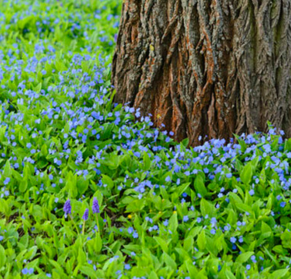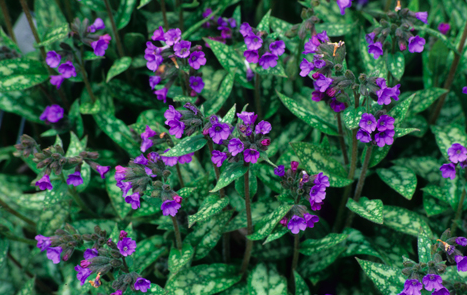Boraginaceae; the family that makes little blue flowers

Blooming now in the arboretum are several large arrays of blue flowered ground covers in the Borage family. They make a stunning effect, especially if you adore carpets of little blue flowers as I do.
There are 146 genera in this family with roughly 2000 species including garden favorites such as Star Flower, Borage, and Forget-Me-Nots, Myosotis, which are annuals and can be grown in the sun.
My two favorite species of Borage are the plants that are in blossom right now; Lungwort and Navelwort. (Many species in the family have the term ‘wort’ in their common name; this indicates that the plant is used medicinally & usually that the plant is an herb. From the Old English ‘wyrt’ or root.)
Both Lungwort and Navelwort are native to the northern hemisphere and tend to grow well in the shady, acidic conditions of temperate coniferous forests.
Lung Wort / Pulmonaria
There was once a school of thought known as ‘The Doctrine Of Signatures,” dating back to the Ancient Greeks and revived by European naturalists in the 15th century, which stated that herbs that resemble certain parts of the human body could be used by herbalists to treat that part of the body. Pulmonaria leaves were thought to resemble the human lungs and therefore it was used a medicinal herb to treat bronchial illnesses. The plant contains compounds which act both as a decongestant and can protect lungs against harmful organisms that can affect respiratory health.1
A semi-evergreen, Pulmonaria’s leaves sport a lovely variegation and a fuzzy texture enjoyable even when the plant is not in bloom.
There are between 15-18 species in the Pulmonaria genus and multiple cultivars that may bear white, pink or purple flowers. Many patches of these can be seen in the Witt Winter Garden and the Woodland Garden.
 Navelwort, Blue Eyed Mary, Creeping Forget-Me-Not / Omphalodes verna
Navelwort, Blue Eyed Mary, Creeping Forget-Me-Not / Omphalodes verna
Named from the Greek ‘Omphalos’ for ‘navel’ referring to the shape of its fruits and ‘verna’ from the Greek for ‘spring’ referring to its bloom time. Although its common name bears the word ‘wort,’ I couldn’t find any information on medicinal usage. It was, however, listed as having poisonous compounds.
Two large carpeted areas can be found covering hillsides under Japanese Maples between the Winter Garden and the Woodland Garden. This plant spreads rhizomatously, but does not seem to be invasive or overly vigorous.
Come enjoy early spring in our arboretum either by yourself or come along on one of our Free Weekend Walks (meet Sundays at the Graham Visitors Center at 1:00 pm) and go out with a knowledgeable guide to explore the plants in our collection.
Sources
- http://www.globalhealingcenter.com/natural-health/9-best-herbs-lung-cleansing-respiratory-support/